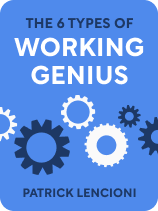

This article is an excerpt from the Shortform book guide to "The 6 Types of Working Genius" by Patrick Lencioni. Shortform has the world's best summaries and analyses of books you should be reading.
Like this article? Sign up for a free trial here.
What is the book The 6 Types of Working Genius about? What’s the best way to get a team to work together?
In The 6 Types of Working Genius, Patrick Lencioni walks you through six intelligence types and how they can bolster organizational well-being. Additionally, he addresses how these intelligence types apply to workflow.
Read below for a brief overview of The 6 Types of Working Genius.
The 6 Types of Working Genius by Patrick Lencioni
Patrick Lencioni’s The 6 Types of Working Genius argues that everyone possesses certain “geniuses,” or intelligence types, and that all successful teams consist of members possessing a combination of each type. By identifying which traits your team members have, you can maximize both productivity and individual fulfillment.
Lencioni is an entrepreneur, best-selling author, and speaker. In 1997, he founded the Table Group, a consultancy firm designed to coach organizations toward optimal health. Since then, Lencioni has dedicated himself to helping businesses cultivate sounder management practices and workplace happiness.
Lencioni begins the book with a fable, a common feature in his works (including The Four Obsessions of an Extraordinary Executive, Death by Meeting, and The Five Dysfunctions of a Team). It tells of a businessman who, despite many professional shifts and successes, still finds himself consistently drained and irritable towards the people around him. After one of his employees delivers some particularly critical feedback regarding these shifting moods, the businessman and members of his team ultimately divulge what tasks they most love and despise at work, thus revealing their particular natural strengths—the framework for the 6 Geniuses is born.
Six Geniuses and the Phases of a Project
Lencioni explains that an intelligence type is intrinsic to the individual, meaning the types reflect what that person is naturally good at. Each intelligence helps people excel at one of six essential activities required during any project, from developing your next product to planning a family vacation to establishing a summer fundraiser for your local charity group. These are Lencioni’s names for the six intelligences as well as the descriptions we’ll use to reference them:
- Wonder: Perceiving Opportunity
- Invention: Innovating Solutions
- Discernment: Vetting Ideas
- Galvanizing: Mobilizing People
- Enablement: Supporting
- Tenacity: Seeing Things Through
We’ll describe each intelligence type in more detail below. For now, it’s important to understand that Lencioni argues that each individual excels in only two intelligence types, that the intelligences are mutually complementing, and that all intelligence types must be represented for a team to succeed.
Lencioni argues that each of these six intelligences has either a responsive (passive) or disruptive (active) quality and that this stems from the source of the intelligence’s inspiration. Passive intelligences draw inspiration from the surrounding world and formulate approaches to changing or reorganizing it—in other words, they respond or react to situations. Active intelligences rely instead on their own internal powers to instigate change or impact behaviors—they create, innovate, and pull ideas from thin air.
Moreover, each intelligence is defined by its role during one of three stages of work that Lencioni defines: ideation, activation, and implementation. From here on out, we’ll refer to these as the brainstorming, set-up, and follow-through phases, respectively, and we’ll describe them in more detail below. Each of these three phases comprises two intelligences—one passive and one active.
Lencioni illustrates the three phases on a downwardly sloping gradient he calls elevation. The earliest phase of work (brainstorming) is at the top, descending through the remaining phases toward the project’s completion. This gradient has a metaphorical quality, where the earliest phases of work occur when our heads are in the clouds and activities are most conceptual. The process then eventually gains practical definition as it descends.
Lencioni emphasizes that one phase of work or intelligence is not better than another—only that they are most effective in a specific sequence in the life cycle of a project. For instance, early-stage discussions typically can’t tolerate too much task-mastering, because they’re meant to be more open and imaginative. Similarly, abstract creativity in later-stage discussions can distract the focus from the project’s execution and last-minute problem-solving. This means that putting team members in positions that don’t capitalize on their unique intelligence can derail the project.
In this section, we’ll study the six intelligences and their essential traits within their respective phases of work.
Phase 1: Brainstorming
Lencioni says the brainstorming stage begins any working process. It involves seeing a need or opportunity and devising ways of addressing or capitalizing on it.
Intelligence #1: Perceiving Opportunity
Category: Passive
The person with this intelligence gets the ball rolling. She recognizes an opportunity in the status quo and contemplates what’s possible. This intelligence is passive because it reacts to external challenges calling out for solutions and is required to catalyze projects.
For example, imagine your company wants to develop a new razor blade for personal care, but that particular market is saturated. This person sees where your competitors are going wrong and why their products don’t fully satisfy consumer demands: because their prices are staggeringly high. Instead of seeing difficulty, the person with this intelligence sees an opportunity—if you could lower production costs while maintaining quality, your company could make its mark.
Intelligence #2: Innovating Solutions
Category: Active
The teammate with this intelligence thinks outside the box. After the person with Perceiving Opportunity intelligence identifies the problem or opportunity, the person who innovates solutions provides an approach to fixing or seizing it through her industrious imagination. This intelligence type is active because it relies on its own inherent creativity and vision and is adept at leading brainstorming sessions with onslaughts of new ideas. The person with this type of intelligence is likely the one who will come up with an ingenious design solution for your new product, and because this intelligence is active. she’ll do so without the need for prompting or direction. Perhaps this person sees how to use a lower-cost but high-quality alloy for your company’s razor blade and that machining this alloy with precision will also take less time than the competitor’s expensive, conventional blade.
Phase 2: Set-Up
This is the critical middle phase of work. This is the time to troubleshoot ideas raised in the previous phase and evaluate their integrity and applicability. This is also the point where the organization must fully commit to the project.
Organizations that dedicate ample time and resources to this phase tend to experience both expedited and positive outcomes. However, according to Lencioni, set-up is typically the most neglected of the three stages of work. When teams rush this phase, they tend to:
- Deliver under-performing outcomes
- Forfeit critical steps that can aid in realizing projects
- Create cycles of mutual blame and resentment among the teammates who lead the previous brainstorming phase and subsequent follow-through phase
Intelligence #3: Vetting Ideas
Category: Passive
The person with this intelligence is the one who determines if the proposals suggested during the brainstorming stage meet the criteria of reality. In other words, are they achievable? This person might be the one to question the feasibility of producing your new item on a competitive scale or warn about how much time and money will go into its development.
This intelligence is passive because it requires the existence of ideas outside itself to evaluate; yet, this person is vital in helping organizations select ambitious yet realistic projects. These are the people in your organization who you constantly look to for their intuition and honesty. The person with this intelligence might point out that supplies of your new alloy are not always reliable, making long-term use an issue, or that engineers have already tried and failed to use it. She may suggest that the company find its own supply source and specific engineering talent to make that avenue safe.
Intelligence #4: Mobilizing People
Category: Active
The teammate with this intelligence encourages teammates to buy in to projects and is indispensable to getting almost any process off the ground. The intelligence is active because it generates energy and enthusiasm and then passes them along to others. This teammate will get everyone oaring in the same direction and to the same tempo, ensuring that effort is concerted and morale is strong. She will relay to your entire staff how revolutionary your new razor design is (how your organization is the first to use that alloy, in particular) and that the price point you’re going to offer will change the entire market.
These attributes make this intelligence of motivating critical to the central phase of work; in essence, it is a cheerleader archetype.
Phase 3: Follow-Through
Lencioni’s final phase involves seeing work to completion. It requires intelligences that supply teams with the resources, guidance, and attention to detail necessary for seeing things through in alignment with the organization’s plan: meeting deadlines, ensuring quality, and holding people accountable.
Intelligence #5: Supporting
Category: Passive
The person with this intelligence notices when teammates require assistance and jumps in to help them. Lencioni says that this person often recognizes that their teammates need help before they realize it themselves, making them indispensable to the team during fever-pitched moments. For instance, this person might observe that machinists in your manufacturing department are having trouble applying the specs given to them by engineering and then obtain clarification for them. Or, they could help the marketing department express the benefits of your chosen alloy in laymen’s terms so investors and customers understand and become intrigued.
According to Lencioni, this intelligence is passive because it involves responding to others on the team who need assistance.
Intelligence #6: Seeing Things Through
Category: Active
The person with this intelligence is the taskmaster. She always keeps the end goal in mind, making sure efficiency, timing, and quality are on point. People with this intelligence love to check boxes—they are relentless, nuts-and-bolts thinkers. This is the person who makes sure your new razor blade is ready for that vital sales quarter, that everyone knows the quality and uniqueness of what they’re selling, and that the product itself delivers value, precision, quality, and durability. She’s often focused on late-stage problem-solving, making her territory the least conceptual and most pragmatic stage of work.
This intelligence is active because its personality provides the drive and focus required to see things through. The principal distinction Lencioni describes between this person and someone with Mobilizing intelligence—the person who energizes and motivates the team during the set-up phase of work—is that mobilizing is about inspiring teammates, whereas seeing things through is about doggedly pursuing the goal.
Genius, Competency, and Frustration
According to Lencioni, the average individual excels in two of the six forms of intelligence. For the other four, she is competent or proficient at two, and she is frustrated or drained by two.
Proficiency means a short-term ability to perform that task. People may be able to use their proficient intelligences when the team experiences shortfalls with related tasks, but when they do so for an extended time, they become exhausted and irritated. Work quality and morale eventually suffer.
The intelligences that drain a person are those that require tasks they struggle with. If your teammates hold authority over tasks that drain them, Lencioni says it will harm their professional happiness and the work’s successful outcome. Additionally, the rest of the team may misinterpret the person’s failure as being the result of low motivation, team spirit, ability, or the like, when in reality it’s due to their being less naturally inclined to that form of labor.
Balanced teams recognize a person’s skill levels across all three categories, allotting tasks and leadership accordingly. To this end, team managers must strive to create transparency regarding what teammates’ competencies and frustrations are. Put differently, employees should feel safe offering feedback regarding the types of work that most drain and discourage them. Indeed, Lencioni insists these deficits are natural to any individual’s range of abilities—just as their intelligences are.
Mapping Genius
After determining each of your team member’s intelligence types, Lencioni encourages mapping them out. This allows you to evaluate your team’s current skillset and where improvements and/or additions are advisable.
To do this, Lencioni suggests listing each intelligence type in the order it appears in the phases of work: Perceiving Opportunity, Innovating Solutions, Vetting Ideas, Mobilizing People, Supporting, and Seeing Things Through. Alongside each, place a field with two columns. In the left-hand column, put the team members who excel in that intelligence; on the right, list those who struggle with it.
Lencioni doesn’t map team members’ intelligences here. Instead, Lencioni emphasizes that you should use the map primarily to visualize major strengths and weaknesses.
Harvesting the Map’s Information
Lencioni insists that the benefits of mapping go well beyond knowing who’s who. You can visually conceptualize where your organization is adequately staffed—in other words, how deep is your proverbial bench? In studying the map, you can then ask key questions:
- Is anyone over-extended because they’re the only one on your team possessing one of the intelligences?
- Likewise, is anyone burning out because their competencies too often have to compensate for deficits of intelligence?
- Who might be “under-utilized” because their true skill set remains unacknowledged? And how can this add balance and bandwidth to the team?
Takeaways from these and similar questions can inform big choices or, at least, important follow-up questions:
- Can you fill gaps solely by moving around existing personnel?
- Can you transfer/borrow people from other departments or teams?
- Is hiring an option? If so, for which intelligences and competencies?
Genius and Overall Organizational Health
Lencioni argues that the implementation of his model, including the mapping techniques mentioned above, will lead to dramatic improvements in your team’s performance, particularly in areas of leadership, productivity, employee retention/morale, and meeting integrity.
The Benefits of Recognizing Genius
First, leadership that follows an intelligence-based approach leads far more organically; it’s better poised to tap into the resources right at its fingertips. It doesn’t shoehorn people into boilerplate job descriptions; rather, it encourages people to follow their talents instead of conventions. Lencioni identifies the following chief benefits for any organization:
- People don’t feel forced to be good at all things, all the time; this means they can focus primarily on the things at which they’re best.
- Team members have greater insights into everyone’s strengths and weaknesses. And instead of blaming one another for those gaps, they embrace them as a natural function of any team.
- Productivity and efficiency increase accordingly.
The benefits are just as striking, Lencioni continues, for employees themselves, as well as for how ensuing morale reflects upon the company. Employees who regularly engage their intelligences and avoid tasks for which they’re less equipped are simply happier. They exude more enthusiasm, stay on the job longer, and the company acquires a reputation as a great place to work.

———End of Preview———
Like what you just read? Read the rest of the world's best book summary and analysis of Patrick Lencioni's "The 6 Types of Working Genius" at Shortform.
Here's what you'll find in our full The 6 Types of Working Genius summary:
- The six types of working intelligence that successful teams need
- How to identify which traits your team members have
- How to apply the six types of genius to bolster workflow and well-being






